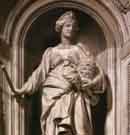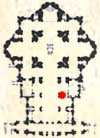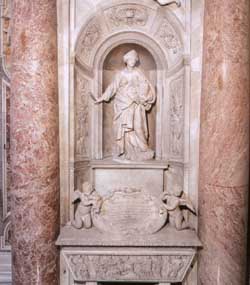| Grottoes
Vatican City Colonnade Saints Floorplan #2 |
| Altars
Monuments The History |
|
Related Sites |
|
The monumental tomb of the countess, made by Gian Lorenzo Bernini and his workshop, consists of a sarcophagus carved with the Submission of the emperor Henry IV to Pope Gregory VII at Canossa, a dedicatory inscription held by two angels, and the statue of Matilda. |

|
From:
'Seminarian's Guide'
She was
Gregory VII's champion against Henry IV, at whose castle the Pope retreated
when the Emperor tried to take the Pope hostage. The relief shows Henry
IV kneeling before the Pope on January 28, 1077 after waiting for three
days and nights to be received!
From:
'St. Peter's - Guide to the Basilica and Square'
On the left, the funeral monument of Countess Matilda di Canossa, Pope
Gregory VII's great champion against the Emperor Henry VI. The monument
was conceived by Bernini who began it in 1633. The statue of Matilda is
by Andrea Bolgi (1605-1656). The central bas-relief which shows Henry
IV knelling before Gregory VII on 28 January 1077 after waiting or three
days and three nights to be received, is the work of Stefano Speranza.
The two cherubs supporting the inscription are by Andrea Bolgi (on the
right) and Luigi Bernini, the brother of Gian Lorenzo (on the left).
From: 'Guide to
St Peter's Basilica' © 2003, Libreria
Editrice Vaticana
The funeral monument to the Countess Matilde of Canossa (1046-1115) is
by Gian Lorenzo Bernini. The work was commissioned by Urban VIII at the
end of 1633. The pontiff had a special veneration for the memory of Matilde
and, in the years before his election, he had exalted poetically this
heroic warrior woman in a literary composition. His wish to honour her
with a worthy burial inside the Vatican Basilica ended with the transfer
of the relics of the Countess from San Benedetto Po, near Mantua to Rome.
On 10th March 1634 the body arrived in the Basilica, where the monument
was already completed and ready. She was one of the most powerful women
in the Middle Ages, benefactress of the Holy See, forever venerated in
the main temple of Christianity. Her marble face inaugurated the series
to female figures in St Peter's. Queen Christina of Sweden's and Maria
Clementina Sobieski's memorials were added later.
From December 1633 to March 1634 an allocation of money for the works was deliberated and the realization started with great care in spring 1634. The whole work of art was displayed to the public and inaugurated on 21st March 1637, on St Benedict's day (although the inscription dates 1635). As it happened later, Bernini was helped by a number of collaborators. Agostino Radi and Alessandro Loreti decided the architectonic structure, while Giuseppe Balsimelli and Niccolo Sale roughed the statue, sculpted by Bernini himself. From March 1634 to February 1636 Stefano Speranza realized the bas-relief representing the forgiveness given by Gregory VII to the Emperor Henry IV on 28th January 1077 at Canossa, before the countess Matilde, her son Amadeo and the abbot Hugh of Cluny. Over the sarcophagus are two puttos: the right one is by Luigi Bernini, Gian Lorenzo's brother, the other is by Andrea Bolgi.
At the top of the arch, Matteo Bonarelli, Andrea Bolgi and Lorenzo Flori sculpted the puttos with the crown and heraldic coat of arms with the pomegranate and the motto: TUETUR ET UNIT (Protects and Unites)
www.britannica.com
When Godfrey died in 1069, Matilda married his son Godfrey the Hunchback,
with whom she resided in Lorraine. After the death of their child in infancy,
she returned to Italy, reigning with her mother until Beatrice's death
in 1076. Matilda's father, for many years a supporter of the German emperors,
had moved toward the papal (Guelf) side in the factional struggle dividing
Italy, and Matilda remained loyal to the popes. She became a close friend
of Pope Gregory VII, lending him important support in his struggle against
the emperor Henry IV, and it was at her castle at Canossa that in January
1077 Gregory received the barefoot penance of the Emperor that marked
an apogee of papal prestige. After Henry's excommunication in 1080, Matilda
was intermittently at war with him until his death (1106), sometimes donning
armor to lead her troops in person. In 1082 she sent part of the famous
treasure of Canossa to Rome to finance the Pope's military operations.
Other Sources
From 1071 Matilda entered upon the government and administration of her
extensive possessions in Middle and Upper Italy. These domains were of
the greatest importance in the political and ecclesiastical disputes of
that time, as the road from Germany by way of Upper Italy to Rome passed
through them. On 22 April, 1071, Gregory VII became pope, and before long
the great battle for the independence of the Church and the reform of
ecclesiastical life began. In this contest Matilda was the fearless, courageous,
and unswerving ally of Gregory and his successors.
On account of the action of the Synod of Worms against Gregory (1076), the latter was compelled to lay Henry IV under excommunication. As the majority of the princes of the empire now took sides against the king, Henry wished to be reconciled with the pope, and consequently traveled to Italy in the middle of a severe winter, in order to meet the pope there before the latter should leave Italian soil on his journey to Germany.


